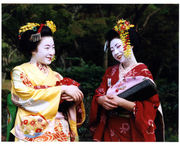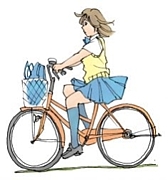通訳案内士(通訳ガイド)試験必携「日本的事象英文説明300選」のご紹介
「日本的事象英文説明300選」は、受験生必携の本として<受験生のバイブル>と呼
ばれていますが、今年の試験が近づいてきたせいか、最近、「300選」についてのお問
い合わせ、購入希望が増えてきましたので、ここで、「300選」のご説明をさせていた
だきます。
「300選」は私が執筆した本ですが、ハロー通訳アカデミーの多くの教材の中でも最も人
気が高く30数年間に15万冊以上販売されてきた「受験のバイブル」で、第1次筆記試験、
第2次口述試験対策の必須教材になっています。
●「300選」の秘密公開!
30数年前に、「300選」初版本を出版した時には、書名に合わせるために項目数は300に
したのですが、その後、十数回に渡り改定版を出す度に、国会議員の定数のように、
○増○減を繰り返し、実は、数年前から項目数は301になっているのです。
項目数を正確に書名に反映させるためには、「301選」とすべきなのですが、増減のたび
に書名変更することはかなり面倒なので、書名は当初から同じ「300選」のままでした。
ちなみに、過去30年間、読者の皆さんから「書名と実際の項目数が違う!」というご指
摘、クレームの類は一切ありませんでした。(丸暗記するのに忙しい!?)
ですから、今後、皆さんが他人に「300選」を紹介する時には、是非、「本当は301の項目
があるけど、書名は300選なのよ。ほら、「一羽でもニワトリ」って言うじゃない。」な
どと言って、「301項目の300選!」の都市伝説化にご協力ください。(笑)
●「日本的事象英文説明300選」の構成と内容
「日本的事象英文説明300選」は、通訳案内士試験によく出題される日本的事象300項
目を下記の12のジャンル(UNIT)別に整理、整理して簡潔な英文にまとめたものです。
全体の約10%にあたる31項目の英文を例示しましたのでご参照ください。
通訳案内士試験で英語以外の外国語で受験される方は、英文を各外国語に翻訳して対
策としていただければよろしいかと存じます。
通訳案内士試験対策だけではなく、広く日本文化を紹介する機会のある方にも便利な
内容です。また、日本について興味のある外国人にプレゼントしても大変喜ばれます。
本書の購入ご希望の方は、下記サイトをご覧ください。
本書を録音した別売CD2枚もございます。
http://
●日本的事象を下記の<12のジャンルに分類、整理>しました。
?地理・歴史
?観光
?料理
?舞台芸術・音楽
?美術・工芸
?スポーツ・娯楽
?宗教
?文化行事・祝祭日
?生活様式
?教育
?ビジネス
?日本人
●各ジャンル別の項目と例文
UNIT?地理・歴史
日本の気候
Japanese Climate
Japan has four clear-cut seasons with a rainy season between spring and summer. The Japanese climate is influenced by geographical location, summer and winter monsoons, ocean currents, and topography.
梅雨
Tsuyu
Tsuyu is the early summer rainy season which begins about the middle of July and lasts about a month. This rain is needed by the farmers at rice-planting time.
台風
Tsuyu
Tsuyu is the early summer rainy season which begins about the middle of July and lasts about a month. This rain is needed by the farmers at rice-planting time
古墳
縄文文化
弥生文化
埴輪
朝廷
将軍
幕府
大名
侍
武士道
鎖国
踏絵
寺子屋
浪人
君が代
UNIT?観光
新幹線
Shinkansen
The Shinkansen is the super-express train nicknamed "The Bullet Train" It first began operating in 1964, the year of the Tokyo Olympics, and now has lines extending from Tokyo to the southern island of Kyushu and northern Honshu.
旅館
Ryokan
Ryokan is a traditional Japanese inn with the interior designed in the traditional Japanese style. The rates usually include breakfast and supper.
民宿
ビジネスホテル
ペンション
カプセルホテル
芸者
日光
Ryokan
Ryokan is a traditional Japanese inn with the interior designed in the traditional Japanese style. The rates usually include breakfast and supper.
箱根
富士山
Fujisan
With a height of 3,776 meters, Mt. Fuji is Japan's highest mountain. Though classified as an active volcano, Mt. Fuji last erupted about 300 years ago. Its almost perfect cone shape is world-famous for its beauty and the mountain is a symbol of Japan.
熱海
鎌倉
広島
青函トンネル
京都
奈良
阿蘇山
松島
天橋立
宮島
後楽園
兼六園
偕楽園
UNIT?料理
天ぷら
Tempura
Tempura is seafood and vegetables that are dipped in batter, deep-fried and served with a special sauce.
緑茶
抹茶
すきやき
Sukiyaki
Sukiyaki is a dish of thinly sliced beef, onions, tofu, and shiitake mushrooms cooked in a pan at the table. Sugar, soy sauce, and sake are added for flavor.
にぎり鮨
海苔巻
回転寿司
刺身
酢の物
しゃぶしゃぶ
お節料理
Osechi-ryori
Osechi-ryori are special dishes for the New Year holidays. A variety of ingredients such as fish, black beans, rolled kelp, and vegetables are prepared and arranged artfully in a set of layered lacquer boxes.
懐石料理
焼鳥
おでん
かば焼
茶わん蒸し
Chawanmushi
Chawanmushi is cup-steamed egg custard with chicken, shrimp, and vegetables. Trefoil leaves are often put on top as a garnish.
味噌
みそ汁
うどん
そば
そうめん
石焼きいも
酒
焼酎
とそ
雑煮
もち
汁粉
精進料理
ちゃんこ鍋
お茶漬
漬物
赤飯
丼物
牛丼
幕の内弁当
雑炊
佃煮
こんにゃく
かつお節
竹輪
かまぼこ
納豆
お好み焼き
たこやき
饅頭
ようかん
おはぎ
煎餅
立ち食いそば
屋台
ファミリーレストラン
居酒屋
割箸
おしぼり
UNIT?舞台芸術・音楽
落語
Rakugo
Rakugo is a funny story usually told by a professional storyteller at a variety hall or on TV. Themes are usually humorous incidents from daily life in the Edo period.
尺八
歌舞伎
Kabuki
Kabuki is a traditional stage drama performed exclusively by men to the accompaniment of songs and music. It is characterized by a combination of rhythmical words, dancing, elaborate costumes, and stage sets.
能
Noh
Noh is a classical stage art performed exclusively by men to the accompaniment of recitative chants called yokyoku and an orchestra consisting of a flute and three types of drums. It is characterized by symbolic, highly stylized acting, and elaborate masks.
狂言
文楽
Bunraku
Bunraku is a classical puppet play performed to the accompaniment of musical ballads known as joruri. Its charm lies in the harmony of skilled puppeteers and the voices of the joruri singer.
浄瑠璃
雅楽
花道
黒衣
漫才
三味線
琴
琵琶
演歌
UNIT?美術・工芸
生け花
Ikebana
Ikebana is the traditional Japanese art of arranging flowers. In its earlier stages of development it was closely related to the tea ceremony, being used as a special technique for decorating the tearoom.
茶の湯
Cha-no-yu
Cha-no-yu is the art and ritual of serving special powdered tea. It originated in the monasteries of Zen Buddhism, but today it is regarded as a form of artistic discipline for the cultivation of mental composure and elegant manners.
書道
書き初め
すずり
水墨画
浮世絵
菊人形
磁器
陶器
漆器
七宝焼
西陣織
友禅
十二支
重要文化財
有形文化財
無形文化財
日本庭園
Nihon-teien
Nihon-teien refers to a landscape garden composed of rocks, trees, ponds, and other natural objects. This type of garden is designed in accordance with the appearance of nature.
枯山水
Karesansui
Karesansui is a dry landscape garden mainly composed of rocks and sand.The rocks represent mountains or islands, while the sand represents water.
借景
石灯籠
盆栽
俳句
和歌
風呂敷
扇子
うちわ
こけし
招き猫
折紙
千羽鶴
のし
根付
判子
UNIT?スポーツ・娯楽
柔道
Judo
Judo was developed as a form of unarmed self-defense, but is now a popular sport. The main concept of judo is the skillful use of balance and timing to turn an opponent's strength against him or her.
合気道
空手
Karate
Karate is a form of unarmed self-defense which originated in Okinawa. It is characterized by sharp, quick blows delivered with the hands and feet.
剣道
弓道
長刀
道場
相撲
高校野球
ゲートボール
はねつき
たこあげ
将棋
碁
マージャン
パチンコ
カラオケ
じゃんけん
UNIT?宗教
神道
仏教
儒教
禅宗
座禅
神社
寺
鳥居
大仏
日本の塔
さいせん箱
だるま
大安
仏滅
檀家
釣鐘
数珠
木魚
観音
地蔵
お守り
絵馬
おみくじ
神輿
狛犬
しめ縄
七福神
稲荷神社
UNIT?文化行事・祝祭日
正月
Shogatsu
Shogatsu is the celebration of the New Year and is the most important holiday in Japan, comparable to Christmas in Western countries. Entrances of houses and buildings are decorated with a set of pine branches and bamboo. A sweet sake called toso, and a soup called zoni are served during the holiday.
しめ飾り
門松
初夢
年賀状
お年玉
初詣
新年会
成人の日
節分
雪祭
建国記念の日
ひな祭
Hina-matsuri
Hina-matsuri is the Doll Festival or Girls' Festival observed on March 3. Dolls dressed in beautiful Heian-era costumes and representing the Emperor, Empress, and their court are displayed to celebrate the growth of the family's girls and to express their hopes that they will become as graceful and beautiful as the Heian nobility.
春分の日
みどりの日
憲法記念日
花見
ゴールデンウィーク
端午の節句
子供の日
こいのぼり
田植え
七夕
海の日
暑中見舞状
中元
お盆
盆踊り
敬老の日
秋分の日
彼岸
体育の日
月見
紅葉狩
文化の日
七五三
勤労感謝の日
天皇誕生日
歳暮
忘年会
大晦日
年越しそば
除夜の鐘
祝日
祇園祭
時代祭
葵祭
UNIT?生活様式
浴衣
Yukata
Yukata is a light cotton kimono for summer wear. It is used for general relaxation and as sleeping wear. Yukata is also commonly worn at some summer events such as local festivals and fireworks displays.
はかま
はちまき
角隠し
紋付
着物
Kimono
Kimono is the long robe with wide sleeves and a broad sash that is traditionally worn as an outer garment by Japanese.
振袖
帯
羽織
はっぴ
十二単衣
足袋
草履
下駄
日本髪
団地
玄関
障子
ふすま
畳
床の間
Tokonoma
Tokonoma is an alcove in a Japanese-style room. It is where a hanging scroll, a vase of arranged flowers or other ornaments are displayed.
掛軸
屏風
のれん
風鈴
ちょうちん
座布団
布団
お見合い
Omiai
Omiai is an arranged meeting with a prospective marriage partner and is a common practice in Japan. Omiai is first arranged by a go-between, usually a mature man or woman of good social standing, but subsequent dates, if any, are agreed on by the couple themselves. A couple may date several times before deciding whether or not to take the step into marriage.
結納
仲人
三三九度
餞別
心中
家紋
宝くじ
歩行者天国
ビアガーデン
銭湯
自動販売機
交番
UNIT?教育
予備校
Yobiko
Yobiko is a preparatory school where students study for entrance examinations to universities. Students who have failed to pass the examinations upon graduation from high school often enter these schools in preparation for another attempt in the following year.
塾
日本の教育制度
修学旅行
ローマ字
漢字
ひらがな
カタカナ
UNIT?ビジネス
終身雇用
Shushin-koyo
Shushin-koyo is the lifetime employment system which has been prevalent in Japanese companies. Under this system, employees are expected to be totally loyal to the company in exchange for guaranteed employment until retirement, usually between the ages of 60 and 65.
年功序列
根回し
稟議
単身赴任
ボーナス
社宅
日本の農業
UNIT?日本人
わび・さび
Wabi and Sabi
Wabi refers to an aesthetic of refined rusticity, and sabi refers to the elegant serenity of desolation. Wabi and sabi are among the highest of aesthetic qualities valued in traditional Japanese arts, particularly the tea ceremony and haiku.
義理・人情
本音と建前
Honne and Tatemae
Honne refers to one's true feelings or motives, whereas tatemae is the face one wears in public. Honne may be expressed privately, while tatemae is an opinion designed for social acceptance.
天皇
以上
「日本的事象英文説明300選」は、受験生必携の本として<受験生のバイブル>と呼
ばれていますが、今年の試験が近づいてきたせいか、最近、「300選」についてのお問
い合わせ、購入希望が増えてきましたので、ここで、「300選」のご説明をさせていた
だきます。
「300選」は私が執筆した本ですが、ハロー通訳アカデミーの多くの教材の中でも最も人
気が高く30数年間に15万冊以上販売されてきた「受験のバイブル」で、第1次筆記試験、
第2次口述試験対策の必須教材になっています。
●「300選」の秘密公開!
30数年前に、「300選」初版本を出版した時には、書名に合わせるために項目数は300に
したのですが、その後、十数回に渡り改定版を出す度に、国会議員の定数のように、
○増○減を繰り返し、実は、数年前から項目数は301になっているのです。
項目数を正確に書名に反映させるためには、「301選」とすべきなのですが、増減のたび
に書名変更することはかなり面倒なので、書名は当初から同じ「300選」のままでした。
ちなみに、過去30年間、読者の皆さんから「書名と実際の項目数が違う!」というご指
摘、クレームの類は一切ありませんでした。(丸暗記するのに忙しい!?)
ですから、今後、皆さんが他人に「300選」を紹介する時には、是非、「本当は301の項目
があるけど、書名は300選なのよ。ほら、「一羽でもニワトリ」って言うじゃない。」な
どと言って、「301項目の300選!」の都市伝説化にご協力ください。(笑)
●「日本的事象英文説明300選」の構成と内容
「日本的事象英文説明300選」は、通訳案内士試験によく出題される日本的事象300項
目を下記の12のジャンル(UNIT)別に整理、整理して簡潔な英文にまとめたものです。
全体の約10%にあたる31項目の英文を例示しましたのでご参照ください。
通訳案内士試験で英語以外の外国語で受験される方は、英文を各外国語に翻訳して対
策としていただければよろしいかと存じます。
通訳案内士試験対策だけではなく、広く日本文化を紹介する機会のある方にも便利な
内容です。また、日本について興味のある外国人にプレゼントしても大変喜ばれます。
本書の購入ご希望の方は、下記サイトをご覧ください。
本書を録音した別売CD2枚もございます。
http://
●日本的事象を下記の<12のジャンルに分類、整理>しました。
?地理・歴史
?観光
?料理
?舞台芸術・音楽
?美術・工芸
?スポーツ・娯楽
?宗教
?文化行事・祝祭日
?生活様式
?教育
?ビジネス
?日本人
●各ジャンル別の項目と例文
UNIT?地理・歴史
日本の気候
Japanese Climate
Japan has four clear-cut seasons with a rainy season between spring and summer. The Japanese climate is influenced by geographical location, summer and winter monsoons, ocean currents, and topography.
梅雨
Tsuyu
Tsuyu is the early summer rainy season which begins about the middle of July and lasts about a month. This rain is needed by the farmers at rice-planting time.
台風
Tsuyu
Tsuyu is the early summer rainy season which begins about the middle of July and lasts about a month. This rain is needed by the farmers at rice-planting time
古墳
縄文文化
弥生文化
埴輪
朝廷
将軍
幕府
大名
侍
武士道
鎖国
踏絵
寺子屋
浪人
君が代
UNIT?観光
新幹線
Shinkansen
The Shinkansen is the super-express train nicknamed "The Bullet Train" It first began operating in 1964, the year of the Tokyo Olympics, and now has lines extending from Tokyo to the southern island of Kyushu and northern Honshu.
旅館
Ryokan
Ryokan is a traditional Japanese inn with the interior designed in the traditional Japanese style. The rates usually include breakfast and supper.
民宿
ビジネスホテル
ペンション
カプセルホテル
芸者
日光
Ryokan
Ryokan is a traditional Japanese inn with the interior designed in the traditional Japanese style. The rates usually include breakfast and supper.
箱根
富士山
Fujisan
With a height of 3,776 meters, Mt. Fuji is Japan's highest mountain. Though classified as an active volcano, Mt. Fuji last erupted about 300 years ago. Its almost perfect cone shape is world-famous for its beauty and the mountain is a symbol of Japan.
熱海
鎌倉
広島
青函トンネル
京都
奈良
阿蘇山
松島
天橋立
宮島
後楽園
兼六園
偕楽園
UNIT?料理
天ぷら
Tempura
Tempura is seafood and vegetables that are dipped in batter, deep-fried and served with a special sauce.
緑茶
抹茶
すきやき
Sukiyaki
Sukiyaki is a dish of thinly sliced beef, onions, tofu, and shiitake mushrooms cooked in a pan at the table. Sugar, soy sauce, and sake are added for flavor.
にぎり鮨
海苔巻
回転寿司
刺身
酢の物
しゃぶしゃぶ
お節料理
Osechi-ryori
Osechi-ryori are special dishes for the New Year holidays. A variety of ingredients such as fish, black beans, rolled kelp, and vegetables are prepared and arranged artfully in a set of layered lacquer boxes.
懐石料理
焼鳥
おでん
かば焼
茶わん蒸し
Chawanmushi
Chawanmushi is cup-steamed egg custard with chicken, shrimp, and vegetables. Trefoil leaves are often put on top as a garnish.
味噌
みそ汁
うどん
そば
そうめん
石焼きいも
酒
焼酎
とそ
雑煮
もち
汁粉
精進料理
ちゃんこ鍋
お茶漬
漬物
赤飯
丼物
牛丼
幕の内弁当
雑炊
佃煮
こんにゃく
かつお節
竹輪
かまぼこ
納豆
お好み焼き
たこやき
饅頭
ようかん
おはぎ
煎餅
立ち食いそば
屋台
ファミリーレストラン
居酒屋
割箸
おしぼり
UNIT?舞台芸術・音楽
落語
Rakugo
Rakugo is a funny story usually told by a professional storyteller at a variety hall or on TV. Themes are usually humorous incidents from daily life in the Edo period.
尺八
歌舞伎
Kabuki
Kabuki is a traditional stage drama performed exclusively by men to the accompaniment of songs and music. It is characterized by a combination of rhythmical words, dancing, elaborate costumes, and stage sets.
能
Noh
Noh is a classical stage art performed exclusively by men to the accompaniment of recitative chants called yokyoku and an orchestra consisting of a flute and three types of drums. It is characterized by symbolic, highly stylized acting, and elaborate masks.
狂言
文楽
Bunraku
Bunraku is a classical puppet play performed to the accompaniment of musical ballads known as joruri. Its charm lies in the harmony of skilled puppeteers and the voices of the joruri singer.
浄瑠璃
雅楽
花道
黒衣
漫才
三味線
琴
琵琶
演歌
UNIT?美術・工芸
生け花
Ikebana
Ikebana is the traditional Japanese art of arranging flowers. In its earlier stages of development it was closely related to the tea ceremony, being used as a special technique for decorating the tearoom.
茶の湯
Cha-no-yu
Cha-no-yu is the art and ritual of serving special powdered tea. It originated in the monasteries of Zen Buddhism, but today it is regarded as a form of artistic discipline for the cultivation of mental composure and elegant manners.
書道
書き初め
すずり
水墨画
浮世絵
菊人形
磁器
陶器
漆器
七宝焼
西陣織
友禅
十二支
重要文化財
有形文化財
無形文化財
日本庭園
Nihon-teien
Nihon-teien refers to a landscape garden composed of rocks, trees, ponds, and other natural objects. This type of garden is designed in accordance with the appearance of nature.
枯山水
Karesansui
Karesansui is a dry landscape garden mainly composed of rocks and sand.The rocks represent mountains or islands, while the sand represents water.
借景
石灯籠
盆栽
俳句
和歌
風呂敷
扇子
うちわ
こけし
招き猫
折紙
千羽鶴
のし
根付
判子
UNIT?スポーツ・娯楽
柔道
Judo
Judo was developed as a form of unarmed self-defense, but is now a popular sport. The main concept of judo is the skillful use of balance and timing to turn an opponent's strength against him or her.
合気道
空手
Karate
Karate is a form of unarmed self-defense which originated in Okinawa. It is characterized by sharp, quick blows delivered with the hands and feet.
剣道
弓道
長刀
道場
相撲
高校野球
ゲートボール
はねつき
たこあげ
将棋
碁
マージャン
パチンコ
カラオケ
じゃんけん
UNIT?宗教
神道
仏教
儒教
禅宗
座禅
神社
寺
鳥居
大仏
日本の塔
さいせん箱
だるま
大安
仏滅
檀家
釣鐘
数珠
木魚
観音
地蔵
お守り
絵馬
おみくじ
神輿
狛犬
しめ縄
七福神
稲荷神社
UNIT?文化行事・祝祭日
正月
Shogatsu
Shogatsu is the celebration of the New Year and is the most important holiday in Japan, comparable to Christmas in Western countries. Entrances of houses and buildings are decorated with a set of pine branches and bamboo. A sweet sake called toso, and a soup called zoni are served during the holiday.
しめ飾り
門松
初夢
年賀状
お年玉
初詣
新年会
成人の日
節分
雪祭
建国記念の日
ひな祭
Hina-matsuri
Hina-matsuri is the Doll Festival or Girls' Festival observed on March 3. Dolls dressed in beautiful Heian-era costumes and representing the Emperor, Empress, and their court are displayed to celebrate the growth of the family's girls and to express their hopes that they will become as graceful and beautiful as the Heian nobility.
春分の日
みどりの日
憲法記念日
花見
ゴールデンウィーク
端午の節句
子供の日
こいのぼり
田植え
七夕
海の日
暑中見舞状
中元
お盆
盆踊り
敬老の日
秋分の日
彼岸
体育の日
月見
紅葉狩
文化の日
七五三
勤労感謝の日
天皇誕生日
歳暮
忘年会
大晦日
年越しそば
除夜の鐘
祝日
祇園祭
時代祭
葵祭
UNIT?生活様式
浴衣
Yukata
Yukata is a light cotton kimono for summer wear. It is used for general relaxation and as sleeping wear. Yukata is also commonly worn at some summer events such as local festivals and fireworks displays.
はかま
はちまき
角隠し
紋付
着物
Kimono
Kimono is the long robe with wide sleeves and a broad sash that is traditionally worn as an outer garment by Japanese.
振袖
帯
羽織
はっぴ
十二単衣
足袋
草履
下駄
日本髪
団地
玄関
障子
ふすま
畳
床の間
Tokonoma
Tokonoma is an alcove in a Japanese-style room. It is where a hanging scroll, a vase of arranged flowers or other ornaments are displayed.
掛軸
屏風
のれん
風鈴
ちょうちん
座布団
布団
お見合い
Omiai
Omiai is an arranged meeting with a prospective marriage partner and is a common practice in Japan. Omiai is first arranged by a go-between, usually a mature man or woman of good social standing, but subsequent dates, if any, are agreed on by the couple themselves. A couple may date several times before deciding whether or not to take the step into marriage.
結納
仲人
三三九度
餞別
心中
家紋
宝くじ
歩行者天国
ビアガーデン
銭湯
自動販売機
交番
UNIT?教育
予備校
Yobiko
Yobiko is a preparatory school where students study for entrance examinations to universities. Students who have failed to pass the examinations upon graduation from high school often enter these schools in preparation for another attempt in the following year.
塾
日本の教育制度
修学旅行
ローマ字
漢字
ひらがな
カタカナ
UNIT?ビジネス
終身雇用
Shushin-koyo
Shushin-koyo is the lifetime employment system which has been prevalent in Japanese companies. Under this system, employees are expected to be totally loyal to the company in exchange for guaranteed employment until retirement, usually between the ages of 60 and 65.
年功序列
根回し
稟議
単身赴任
ボーナス
社宅
日本の農業
UNIT?日本人
わび・さび
Wabi and Sabi
Wabi refers to an aesthetic of refined rusticity, and sabi refers to the elegant serenity of desolation. Wabi and sabi are among the highest of aesthetic qualities valued in traditional Japanese arts, particularly the tea ceremony and haiku.
義理・人情
本音と建前
Honne and Tatemae
Honne refers to one's true feelings or motives, whereas tatemae is the face one wears in public. Honne may be expressed privately, while tatemae is an opinion designed for social acceptance.
天皇
以上
|
|
|
|
|
|
|
|
通訳案内士は民間外交官! 更新情報
-
最新のアンケート
通訳案内士は民間外交官!のメンバーはこんなコミュニティにも参加しています
人気コミュニティランキング
- 1位
- パニック障害とうつ病
- 8436人
- 2位
- 音楽が無いと生きていけない
- 196006人
- 3位
- マイミク募集はここで。
- 89506人
























